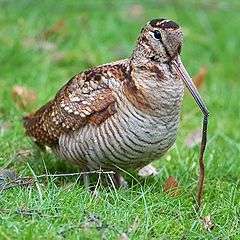Woodcock
| Woodcock | |
|---|---|
 | |
| Eurasian woodcock | |
| Scientific classification | |
| Kingdom: | Animalia |
| Phylum: | Chordata |
| Class: | Aves |
| Order: | Charadriiformes |
| Suborder: | Scolopaci |
| Family: | Scolopacidae |
| Genus: | Scolopax Linnaeus, 1758 |
| Diversity | |
| 8 living species | |
The woodcocks are a group of seven or eight very similar living species of wading birds in the genus Scolopax. The genus name is Latin for a snipe or woodcock, and until around 1800 was used to refer to a variety of waders.[1] The English name was first recorded in about 1050.[2]
Only two woodcocks are widespread, the others being localized island endemics. Most are found in the Northern Hemisphere but a few range into the Greater Sundas, Wallacea and New Guinea. Their closest relatives are the typical snipes of the genus Gallinago.[3][4]
Description and ecology
Woodcocks have stocky bodies, cryptic brown and blackish plumage and long slender bills. Their eyes are located on the sides of their heads, which gives them 360° vision.[5] Unlike in most birds, the tip of the bill's upper mandible is flexible.[3][6][7]
As their common name implies, the woodcocks are woodland birds. They feed at night or in the evenings, searching for invertebrates in soft ground with their long bills. This habit and their unobtrusive plumage makes it difficult to see them when they are resting in the day. Most have distinctive displays known as "roding", usually given at dawn or dusk.[3][7][8]
The range of breeding habits of the Eurasian woodcock extends from the west of Ireland eastwards across Europe and Asia preferring mostly boreal forest regions engulfing northern Japan, and also from the northern limits of the tree zone in Norway. Continuing south to the Pyrenees and the northern limits of Spain. Nests have been found in Corsica and there are three isolated Atlantic breeding stations in Azores, Madeira and the Canary Islands. In Asia the sites can be seen as far south as Kashmir and the Himalayas.
Hunting
Some woodcocks being popular gamebirds, the island endemic species are often quite rare due to overhunting. The pin feathers (coverts of the leading primary feather of the wing) of the Eurasian woodcock are sometimes used as brushtips by artists, who use them for fine painting work.[9]
Species
The following species of woodcocks are extant today:[3][8]
- Eurasian woodcock, Scolopax rusticola (large Eurasian range)
- Amami woodcock, Scolopax mira (endemic to the Amami Islands in Japan)
- Javan woodcock, Scolopax saturata (endemic to Sumatra and Java in Indonesia)
- New Guinea woodcock, Scolopax rosenbergii (endemic to New Guinea)
- Bukidnon woodcock, Scolopax bukidnonensis (endemic to Luzon and Mindanao in the Philippines)
- Sulawesi woodcock, Scolopax celebensis (endemic to Sulawesi in Indonesia)
- Moluccan woodcock, Scolopax rochussenii (endemic to the Maluku Islands in Indonesia)
- American woodcock, Scolopax minor (large North American range)
Fossil record
A number of woodcocks are extinct and are known only from fossil or subfossil bones. Due to their close relationship to the Gallinago snipes, the woodcocks are a fairly young group of birds, even considering that the Charadriiformes themselves are an ancient lineage. Gallinago and Scolopax diverged probably around the Late Miocene some 10-5 million years ago.
- "Scolopax baranensis" (fossil, Early Pliocene of Hungary; a nomen nudum)
- Scolopax carmesinae (fossil, Early/Middle Pliocene? of Menorca, Mediterranean)
- Scolopax hutchensi (fossil, Late Pliocene – Early Pleistocene of Florida, USA)
- Puerto Rican woodcock, Scolopax anthonyi (prehistoric)
- Hispaniola woodcock, Scolopax brachycarpa (subfossil, Holocene of Haiti)
References
| Wikimedia Commons has media related to Scolopax. |
- ↑ Jobling, James A (2010). The Helm Dictionary of Scientific Bird Names. London: Christopher Helm. p. 351. ISBN 978-1-4081-2501-4.
- ↑ "Woodcock". Oxford English Dictionary (3rd ed.). Oxford University Press. September 2005. (Subscription or UK public library membership required.)
- 1 2 3 4 Hayman, Peter; Marchant, John & Prater, Tony (1986): Shorebirds: an identification guide to the waders of the world. Houghton Mifflin, Boston. ISBN 0-395-60237-8
- ↑ Thomas, Gavin H.; Wills, Matthew A. & Székely, Tamás (2004). "A supertree approach to shorebird phylogeny". BMC Evolutionary Biology. 4: 28. doi:10.1186/1471-2148-4-28. PMC 515296
 . PMID 15329156. Supplementary Material
. PMID 15329156. Supplementary Material - ↑ woodcock (bird) – Britannica Online Encyclopedia. Britannica.com. Retrieved on 2013-03-10.
- ↑ Mousley, H. (1934). "The earliest (1805) unpublished drawings of the flexibility of the upper mandible of the woodcock's bill" (PDF). Auk. 51 (3): 297–301. doi:10.2307/4077657.
- 1 2 McKelvie, Colin Laurie (1993): Woodcock and Snipe: Conservation and Sport. Swan Hill.
- 1 2 Kennedy, Robert S.; Fisher, Timothy H.; Harrap, Simon C.B.; Diesmos, Arvin C: & Manamtam, Arturo S. (2001). "A new species of woodcock from the Philippines and a re-evaluation of other Asian/Papuasian woodcock" (PDF). Forktail. 17 (1): 1–12.
- ↑ Dowden, Joe Francis (2007). The Landscape Painter's Essential Handbook. Newton Abbot, UK: David & Charles. p. 7. ISBN 0-7153-2501-9.
External links
- Arthur Cleveland Bent. Life Histories of Familiar North American Birds: American Woodcock (Scolopax minor). Published in 1927: Smithsonian Institution United States National Museum Bulletin 142 (Part 1): 61–78.
- The short film "Woodcock Woodlands" is available for free download at the Internet Archive
